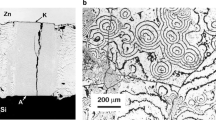Abstract
Conditions providing a thermodynamic advantage governing the self-assembly of Zn and Te impurities in metastable magnesium sulfide (MgS) with zinc-blende structure have been theoretically studied. The formation of tetrahedral 1Te4Zn cells is thermodynamically favorable in ZnxMg1 − x TeyS1 − y (x ≥ 4y) solid solutions enriched in MgS in the region of dilute Te concentrations. At temperatures selected for the growth (230°C) and annealing (500°C), the free energy of a solid solution in which separate Te atoms must be surrounded only by Zn atoms is lower than that of the solution with a random arrangement of these impurities. This phenomenon is due to a thermodynamic advantage of the formation of Mg-S and Zn-Te bonds over Zn-S and Mg-Te bonding, as well as due to a decrease in the elastic strain energy upon self-assembly of the given isoelectronic impurities.
Similar content being viewed by others
References
V. A. Elyukhin, V. M. Sanchez, and O. V. Elyukhina, Appl. Phys. Lett. 85, 1704 (2004).
C. Bradford, C. B. O’Donnel, B. Urbaszek, et al., Phys. Rev. B 64, 195309 (2001).
R. T. Sanderson, Chemical Bonds and Bond Energy (Academic, New York, 1971), p. 136.
S. Ekbundit, A. Chizmeshya, R. La Violette, et al., J. Phys.: Condens. Matter 8, 8251 (1996).
Landolt-Bomstein New Series, Ed. by O. Madelung (Springer, Berlin, 1982), Vol. 17b.
V. B. Parker, D. D. Wagman, and W. H. Evans, Selected Values of Chemical Thermodynamic Properties, NBS Technical Note 270–6 (Inst. Mater. Res. NBS, Washington, 1971), p. 19.
R. T. Sanderson, Chemical Bonds and Bond Energy (Academic, New York, 1971), p. 15.
A.-B. Chen and A. Sher, Semiconductor Alloys: Physics and Materials. Engineering (Plenum, New York, 1995), p. 302.
D. Wolverson, D. M. Bird, C. Bradford, et al., Phys. Rev. B 64, 113203 (2001).
R. M. Martin, Phys. Rev. B 1, 4005 (1970).
S. Adachi, Handbook on Properties of Semiconductors (Kluwer, Boston, 2004), Vol. 3, p. 54.
M. Ichida, A. Masuda, A. Yamomoto, et al., Phys. Status Solidi C 3, 2745 (2003).
T. Geppert, J. Wagner, K. Kohler, et al., Appl. Phys. Lett. 80, 2081 (2002).
Author information
Authors and Affiliations
Additional information
Original Russian Text © O.V. Elyukhina, G.S. Sokolovskă, V.I. Kuchinskă, VA. Elyukhin, 2006, published in Pis’ma v Zhurnal Tekhnicheskoĭ Fiziki, 2006, Vol. 32, No. 18, pp. 82–87.
Rights and permissions
About this article
Cite this article
Elyukhina, O.V., Sokolovskiĭ, G.S., Kuchinskiĭ, V.I. et al. Self-assembling of zinc and tellurium impurities in zinc-blende MgS. Tech. Phys. Lett. 32, 818–820 (2006). https://doi.org/10.1134/S1063785006090240
Received:
Issue Date:
DOI: https://doi.org/10.1134/S1063785006090240




